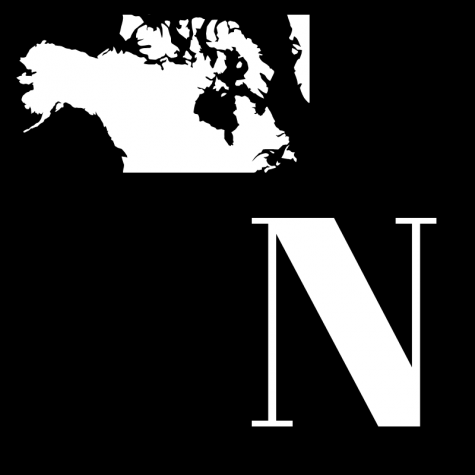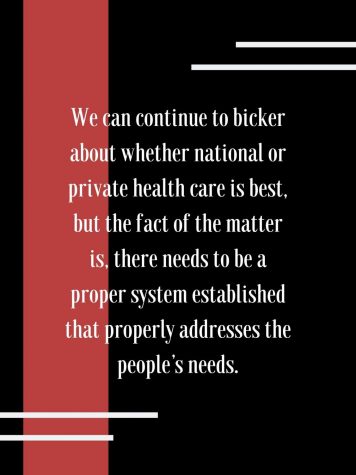A matter of health: Canada’s health care
December 13, 2019
 ational health care has always been a highly debated topic and we’ve seen the issue take centerstage through the Democratic primaries, with candidates Bernie Sanders and Elizabeth Warren being its staunchest supporters. When the debate over the feasibility of universal health care comes into question, Canada is often brought up as a stellar example of universal health care.
ational health care has always been a highly debated topic and we’ve seen the issue take centerstage through the Democratic primaries, with candidates Bernie Sanders and Elizabeth Warren being its staunchest supporters. When the debate over the feasibility of universal health care comes into question, Canada is often brought up as a stellar example of universal health care.
The U.S.’ health care system consists primarily of private programs with a handful of public ones. While there are public programs, those typically apply to individuals who are disabled or in poverty. Of these public health programs, a few of the most prominent ones are Medicaid and Obamacare. Medicaid applies to individuals 65 and older, pregnant women, children, individuals considered medically needy and young adults who meet the requirements for eligibility as a former foster care recipient. These qualifications do cover a wide amount of the population, however for those who are not eligible there is the Affordable Care Act, most commonly referred to as Obamacare. Obamacare creates specific enrollment opportunities for those who can’t meet Medicaid qualifications or can’t get healthcare from private employers.
We often hear about Canada’s successful health care system, yet most of us are unaware about how the system exactly works. We seem to be ignorant of its limitations, and how it helps beyond just free healthcare for all. The funding principle of Canada’s health care, Medicare, is based on need rather than ability to pay. While Canada’s health care system is considered national, that’s actually a misnomer, it actually is a decentralized collection of provincial and territorial insurance plans covering medical services.
According to Canada’s government website, the federal government is in charge of regulating and administering national principles alongside providing funds for provincial services. This is all based on the Canada Health Act which establishes the criteria provinces and territories must fulfill in order to receive federal funding.
Listed in this criteria is that all provinces and territories provide access to medical services. In addition, the act greatly discourages extra-billing and user fees. While this system relies heavily upon taxpayer money with 11.7 percent of Canada’s GDP going into health care, it allows for a greater scope of coverage. While the U.S.’ Medicaid is similar to Canada’s Medicare, Medicaid only applies to people who meet certain requirements, which varies from state to state.
In contrast to Canada, which is able to sustain generally wide coverage, the U.S. has what is essentially a marketplace. Additionally, the type of health care coverage that we receive varies from company to company, and frequently the coverage is equivalent to the price. While we do have programs aimed specifically at those in need, disabled citizens and veterans don’t receive the same coverage and care as those living in Canada.

While Canada’s government oversees operation, the provincial and territorial governments deliver most of Canada’s health care services. Each plan provides the basic medical needs of hospital check ups and medication without extra charges at service points, as these plans are funded by the government and taxes. While the basic amenities are provided specialized doctors or medications may be harder to procure.
With Canada’s health care falling into one system, the matter of competition is removed. What this results in is doctors being funded primarily by the government rather than separate corporations. In contrast, in the U.S. we have various companies which provide various bonuses or benefits to bolster competition, which can result in some services being left out. This could mean that adults in the family are covered but not the kids and a separate health care must be bought for them, or the health care service does not cover specific medications. This is especially concerning with many high need medicines being controlled by private companies like big pharma, where the prices of medication without insurance can cost inexorable amount of money. These high need medicines can range from epipen, inhalers, and even insulin, a medicine that according to American Diabetes Association 30.3 million people in the U.S. need.
While we can nitpick and criticize the various aspects of the U.S. health care system, we have become accustomed to it. We are starting to ask for a change and what we have gotten, Obamacare, has worked to an extent. According to Statista, Obamacare helped insure 20 million more people as of 2017. However despite that it still isn’t guaranteed, which is a major complication. Additionally, the current president has attempted to dismantle this system. Furthermore, while we are seeing a stronger desire for change, there is just as much pushback from those who don’t want their money being used for a nationwide insurance or simply want to keep their private practitioner.
We can continue to bicker about whether national or private health care is best, but the fact of the matter is, there needs to be a proper system established that properly addresses the people’s needs. We cannot simply leave Obamacare as it is, because although it widens the number of people qualified it still lacks in covering many Americans. Additionally we should not remove it as it does provide affordable healthcare for those in need. We must put our differences aside and view this as a national problem rather than a political issue, in order to properly address the issue with U.S.’ healthcare.



























